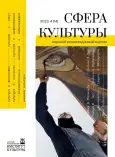Том 4, № 4 (2023)
- Год: 2023
- Выпуск опубликован: 23.11.2023
- Статей: 10
- URL: https://journals.eco-vector.com/2713-301X/issue/view/8232
Весь выпуск
Культура и философия
Оправдание культуры sub specie оправдания истории в русской религиозно-философской мысли
Аннотация
Суждения В.Ф. Эрна о логосной традиции русской мысли, определяющей единство подходов ее деятелей к коренным мировоззренческим проблемам, открывают перспективу реконструкции представлений о смысле и задачах культуры в той линии отечественной философии, которая связана с идеей оправдания истории. Автор настоящего исследования доказывает, что, выступая против историософского пессимизма и катастрофизма, русские христианские мыслители выдвигают задачу оцерковления всех сфер и планов жизни, понимая культуру как орудие преображения мира. Процессам её секуляризации философы противопоставляют литургизацию культурного делания, которую рассматривают в контексте заповеди «обладания землей». В этом отношении особое значение приобретает учение Н.Ф. Федорова, который призывал к переходу от культуры (как символического воскрешения) к рекреатуре – действительному восстановлению жизни.
 13-26
13-26


Как русской идее выйти из плена интеллектуального иррационализма
Аннотация
Авторы осмысливают проблему культурного наследия русской идеи с позиции ментальных структур, исторически сложившихся и актуальных для российского общества. Показано, что русская модель познания иррациональна и восходит к платонической модели эйдоса – познания не столько как рационализации и абстрагирования, сколько морального восхождения. Стремясь к Алетейе (духу истины и искренности), выступающей одним из маркеров русской культуры, духовное самоопределение народа по-прежнему опирается на идеализированные мифологемы уникального пути, что обесценивает и собственное рациональное, и заимствованное идеальное.
 27-37
27-37


Время в оптике десубстантивации
Аннотация
В данном исследовании рассматривается соотнесенность времени как фундаментального параметра представлений о мире с сознанием и культурой. Автор раскрывает связь времени и языка, предпринимает лингвистический анализ значений слова «время», выявляя его этимологические различия в индоевропейских языках.
Затрагивается вопрос о метафорической образности времени в языке. Осуществляется историческая реконструкция взглядов на время в оптике десубстантивации через Аристотеля к Аврелию Августину, Мартину Хайдеггеру и Эдмунду Гуссерлю. На примере рецепции музыкальных тонов анализируется процесс синтезирования темпоральных восприятий в сознании.
 38-46
38-46


Культура и текст
Сергей Есенин и Поль Верлен: историко-литературные параллели и контексты
Аннотация
В исследовании впервые на системной основе выявляются историко-литературные параллели между художественными мирами лидера французской школы поэтовсимволистов Поля Верлена (1844–1896) и Сергея Есенина (1895–1925). Приводятся факты, доказывающие, что еще прижизненная критика улавливала в поэтическом слоге Есенина «верленовские» начала, рассматривая его как последователя постсимволистских тенденций в русской поэзии первой четверти XX в., как крестьянского поэтасимволиста. Близость двух поэтов раскрывается автором в рамках сравнительнотипологического анализа. Показано сходство в звучании антиурбанистической тематики, психологизированном воссоздании образов природы – «пейзажей души», в поэтике цвета, исповедальной манере лирического высказывания, элегической тональности поздних стихов.
 49-59
49-59


Культура и искусство
Синергийная эстетика
Аннотация
Автор обосновывает оригинальное, междисциплинарное и во многом дискуссионное представление о синергийной эстетике, в основе которого богословское понимание развития христианской цивилизации как бесконечного сотворчества Бога и человека (со-творца), устремленного к цели Творения – наступлению Царствия Божия.
Красота музыкальных и литературных шедевров, произведений изобразительного и монументального искусства, гармония научных теорий – результат открытия вечной новизны бытия через Божию благодать. В статье приводятся примеры, свидетельствующие о синергийном восприятии творческого и исполнительского вдохновения в сфере искусства как откровения, поступившего свыше. Особое внимание уделяется синергийной эстетике музыкального исполнительства.
 63-72
63-72


Иконография и сюжетные особенности Сызранской старообрядческой иконы
Аннотация
Долгое время сызранская иконопись, выполненная в традициях византийского и древнерусского искусства, оставалась одним из наименее изученных явлений русской художественной культуры XVIII–XX веков. Сызранские иконы создавались несколькими поколениями староверов (поморского и федосеевского согласий) и предназначались для старообрядческих храмов. Данная статья посвящена произведениям Сызранского иконописного центра Среднего Поволжья, их иконографическим и сюжетным особенностям.
 73-82
73-82


Католицизм в стиле поп-арт Энди Уорхола
Аннотация
По мнению современных искусствоведов, жизнь и творчество выдающегося представителя американского авангарда Э. Уорхола пронизана тайными религиозными мотивами. Обращаясь к биографии и произведениям художника, автор настоящего исследования доказывает, что Энди скрывал конфессиональную принадлежность от окружающих, в чем ему помогала эстетика поп-арта. В своем творчестве, играющем роль молитвенной практики, он представил публике католицизм в трансформированном виде – посредством образов и вещей общества потребления. За банальностью изображаемого скрывалась идея бренности бытия. Автор статьи доказывает, что серийность полотен и акцент на форме вуалировали мысль о бренности, придавая изображаемому сакральность и превращая объект в идол или фетиш. Организованные художником «Фабрики» представляли собой сакральное пространство, в котором все поклонялись Энди как «римскому папе» поп-арта. Проведенный анализ раскрыл сферу потаенного медийного художника, имевшего реноме короля эпатажа и боявшегося разоблачений, противоречащих созданной репутации.
 83-93
83-93


Культура и цифровизация
Мультимедийное издание по истории гравюры: обоснование проекта
Аннотация
Цифровая часть мирового и российского книжного рынка с каждым годом неуклонно растет, успешно конкурируя с издательской продукцией, выполненной традиционным печатным способом. Авторы приводят обоснование проекта мультимедийного электронного издания, отражающего историю зарубежной и отечественной гравюры в форме мобильного приложения. Особое внимание уделено описанию его отдельных мультимедийных элементов, в том числе средств навигации, оглавления и указателей.
Структура электронного издания выстраивалась с учетом хронологии развития искусства гравюры. Статья проиллюстрирована скриншотами, раскрывающими интерфейс данного ресурса, его функциональные возможности.
 97-109
97-109


Книжная культура
Офицерские библиотеки при губернских резервных пехотных батальонах Российской империи во второй половине XIX века: планы и реальность
Аннотация
На основе широкого круга дореволюционных источников впервые показана инициативная роль редакции журнала «Военный сборник» в организации обсуждения различных вариантов устройства офицерских библиотек, в том числе при губернских резервных пехотных батальонах. Представлены финансовые расчеты данной редакции по созданию офицерских библиотек при 58 губернских батальонах в губернских городах Европейской России. Установлена общая численность губернских батальонов, в которых предположительно могли находиться офицерские библиотеки. Раскрыта роль государства в их финансировании. Приведены конкретные примеры создания в Сибири офицерских библиотек Тобольского и Иркутского резервных пехотных батальонов на основе печатных каталогов и дополнений к ним.
 113-130
113-130


Документальное наследие и библиография
Д.В. Ульянинский – несостоявшийся собиратель литературы о революционном движении в России
Аннотация
В исследовании рассмотрен неизвестный эпизод библиофильской деятельности знаменитого книгособирателя и библиографа Д.В. Ульянинского (1861–1918). В 1905–1906 гг. под влиянием революционных событий он начал формировать в своей библиотеке раздел, посвященный освободительному движению в России. Библиофил осознал сложность обеспечения полноты комплектования по данной тематике в условиях роста издательского репертуара, получившего название «брошюрный поток». В итоге он ликвидировал данный раздел своего собрания в августе 1906 года. В статье на основе рукописного «Каталога новых приобретений библиотеки» Д.В. Ульянинского приводятся сведения о составе «революционной коллекции» библиофила.
 133-142
133-142












